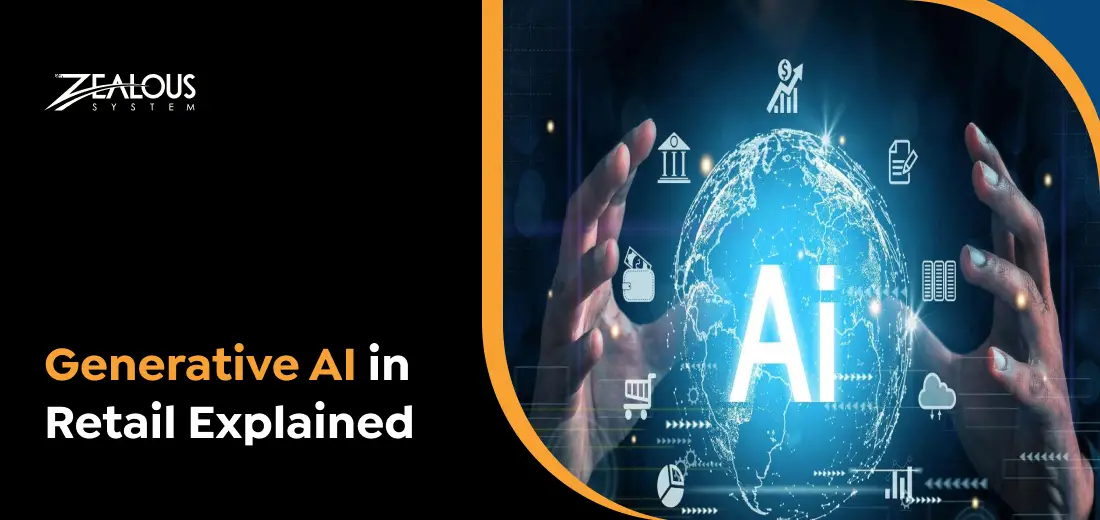


The retail industry is super competitive, so there’s no room to slack off. To get ahead, innovation is key. In 2024, artificial intelligence (AI) and machine learning are going to be game-changers. They’ll transform everything from how supply chains are managed to how we interact with customers.
A survey by NVIDIA reveals that 98% of retailers plan to invest in generative AI models within the next 18 months. This surge in interest is understandable given the significant benefits. Generative AI enhances personalized recommendations, optimizes supply chain management software, increases customer loyalty, and improves inventory management.
This article delves into various applications of generative AI in retail, highlighting how this transformative technology can increase revenue, reduce operating costs, and enhance retailer profitability.
Before exploring the various use cases, it’s important to understand what Generative AI is. Simply put, Generative AI is a technology that enables machines to create new content, ideas, or solutions autonomously. By utilizing machine learning algorithms, Generative AI has the potential to revolutionize the retail industry by promoting innovation, enhancing customer experiences, and streamlining operations.
This technology is a fascinating area that mixes artificial intelligence solutions with creativity. It lets machines go beyond just following rules and create unique things based on patterns and data they’ve learned. This tech is especially useful in retail, where personalization and innovation are super important.

One of the most important use cases of Generative AI is Personalized marketing, which focuses on delivering the right message to the right customer at the right time. With Generative AI, businesses can analyze vast customer data, such as demographics, browsing history, and purchase behavior, to craft highly personalized marketing campaigns.
Generative AI algorithms process this data to generate valuable insights, enabling retailers to customize their marketing messages for each customer. By this use case of Generative AI, retailers can send targeted emails, recommend relevant products, and deliver personalized advertisements, leading to higher customer engagement and conversion rates.
For example, Sephora uses Generative AI to send customized beauty recommendations to customers based on their purchase history and preferences. By generating unique marketing materials for each customer, Sephora can engage its audience more effectively, resulting in higher conversion rates and increased customer loyalty.
Example: Sephora
Sephora leverages its extensive customer data and AI capabilities to deliver personalized beauty recommendations. When a customer shops at Sephora, their preferences, purchase history, and even skin tone and concerns are logged into a database. Generative AI processes this data to craft personalized emails that suggest products tailored to the customer’s needs.
For example, customers who frequently buy skincare products might receive recommendations for new moisturizers or serums. Additionally, the AI can generate targeted social media ads that reflect individual preferences, driving engagement and sales. This has helped Sephora enhance the online shopping experience for its customers and increase sales of its beauty products.
Another use cases of Generative AI is the development of new product designs by analyzing current market trends, customer interactions, consumer preferences, and historical sales data. The Generative AI model can produce multiple variations, enabling companies to shortlist the most appealing options.
Nike, for instance, employs AI to create innovative shoe designs. This technology allows the company to rapidly prototype new products, ensuring that they meet market demands while also fostering creativity.
Example: Nike
Nike uses generative AI to innovate its product design process. By feeding the AI with data on materials, biomechanics, and fashion trends, the technology generates numerous design possibilities. For example, Nike’s AI might analyze the properties of different materials to suggest the most comfortable and durable combinations for running shoes.
The AI can also propose aesthetic designs that resonate with current fashion trends. This approach not only speeds up the design process but also ensures that the final products are both functional and stylish. An example is the Nike Flyknit, a line of shoes designed with AI input to optimize performance and comfort.
Another exciting application of Generative AI in personalized shopping experiences is virtual try-ons. Using augmented reality and computer vision, AI algorithms enable customers to virtually try on products, such as clothing and accessories, without needing to visit a store.
This not only enhances the shopping experience but also reduces the hassle of returns and exchanges. Retailers like Zara are implementing virtual fitting rooms powered by AI. These tools allow customers to visualize how clothes would look on them without physically trying them on. By analyzing body dimensions and simulating different outfits, generative AI helps reduce return rates and enhances customer satisfaction.
Example: Zara
Zara’s virtual fitting rooms use generative AI to create a realistic simulation of how clothes will look and fit on different body types. When customers shop online, they can input their body measurements, and the AI generates a 3D avatar that mirrors their physique. Customers can then virtually try on various outfits to see how they fit and look from different angles.
This technology not only enhances the shopping experience but also reduces the likelihood of returns due to sizing issues. For instance, if a customer is unsure about the fit of a dress, the virtual fitting room can provide a realistic preview, helping them make a more informed purchase decision.
Inventory management is a crucial component of retail operations, focused on maintaining optimal stock levels while minimizing costs and risks. Traditional methods often depend on manual processes and guesswork, leading to inefficiencies and errors.
However, AI can transform inventory management practices. AI algorithms analyze vast amounts of historical sales data, market trends, and external factors to accurately forecast demand. By identifying patterns and correlations in the data, AI provides valuable insights into future demand fluctuations. Walmart, for instance, uses Generative AI to forecast inventory needs. By analyzing past sales data, market trends, and customer behavior, AI can suggest optimal stock levels, minimizing overstock and stockouts. This ensures that products are available when customers need them, improving overall inventory efficiency.
Example: Walmart
Walmart employs generative AI to enhance its inventory management software. The AI analyzes vast amounts of data, including historical sales, seasonal trends, and external factors like economic indicators and weather patterns, to predict future demand.
For example, if the Generative AI detects a trend indicating an increase in demand for certain products during a specific season, it will recommend stocking up on those items in advance. This predictive capability helps Walmart maintain optimal inventory levels, reducing both excess stock and shortages. An example is during the holiday season, where AI-driven forecasts enable Walmart to stock popular items adequately, ensuring availability for customers and maximizing sales.
Generative AI-powered chatbots are becoming increasingly popular in the retail industry. Utilizing natural language processing and machine learning, chatbots can understand customer queries and provide relevant information or assistance. These virtual assistants can handle a wide range of customer inquiries, such as order tracking, product information, and returns, effectively reducing the workload of customer support teams and offering round-the-clock assistance.
Example: H&M
H&M uses generative AI chatbots to enhance customer service. These chatbots are integrated into H&M’s website and mobile app, providing immediate assistance to customers. For example, if a customer has a question about a product’s availability or needs help with sizing, the chatbot can quickly retrieve and provide this information.
The AI also assists with product recommendations based on browsing history and preferences. If a customer is unsure about what to buy, the chatbot can suggest items that match their style and past purchases. This not only improves the customer experience but also frees up human customer service representatives to handle more complex issues.
So far, the spotlight on generative AI use cases in retail has largely centered on its use in creating images and text for product descriptions, blogs, social media, and other promotional avenues. This has sparked speculation about how Gen AI will influence the dynamics between brands, agencies, and other vendors, potentially reshaping job opportunities.
Cosmetics retailer Lush, for example, uses AI to generate engaging content that resonates with their audience. By automating content creation, retailers can maintain a consistent online presence without manual effort, freeing up resources for strategic initiatives.
Example: Lush
Lush utilizes generative AI to streamline its content creation process. The AI analyzes current trends, customer preferences, and engagement metrics to produce content that resonates with Lush’s audience. For instance, the AI might generate blog posts about the benefits of natural ingredients in skincare, or create social media posts highlighting new product launches and promotions.
By automating these tasks, Lush ensures a steady flow of high-quality content that keeps customers engaged. This approach allows the marketing team to focus on strategic planning and creative development, rather than routine content generation.
Generative AI is changing the retail industry by providing innovative solutions across various domains, from personalized marketing to product design and customer service. Retailers adopting this technology can enhance operational efficiency, provide better customer experiences, and stay ahead in a competitive market. As generative AI services continues to evolve, its applications in retail will expand, offering even more
Our team is always eager to know what you are looking for. Drop them a Hi!
Comments